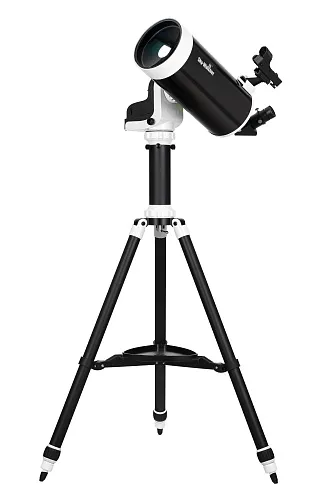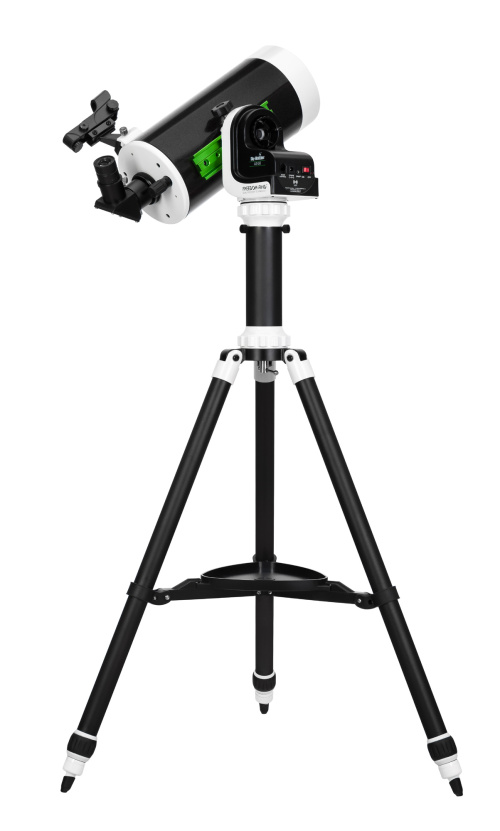Sky-Watcher MAK127 AZ-GTi GOTO Telescope
Maksutov-Cassegrain with GoTo function. Aperture: 127mm. Focal length: 1500mm
Catadioptric
Optical design
127
Aperture – the diameter of the light-collecting lens (refractors and catadioptric) or mirror (reflectors) that the telescope uses to collect light
1500
Focal length – the distance from the primary lens or mirror to the point at which the light is focused
| Product ID | 73709 |
| Brand | Sky-Watcher |
| EAN | 5905555018898 |
| Package size (LxWxH) | 24x85x42 cm |
| Shipping Weight | 10.7 kg |
| Optical design | catadioptric |
Description
Specifications
| Product ID | 73709 |
| Brand | Sky-Watcher |
| EAN | 5905555018898 |
| Package size (LxWxH) | 24x85x42 cm |
| Shipping Weight | 10.7 kg |
| Optical design | catadioptric |
| Optical scheme | Maksutov-Cassegrain |
| Optics material | optical glass |
| Optics coating | aluminum with a protective layer of fused quartz |
| Primary mirror diameter (aperture), mm | 127 |
| Focal length, mm | 1500 |
| Highest practical power, x | 254 |
| Aperture ratio | f/11.8 |
| Eyepieces | PHOTO 10 mm (150x), PHOTO 20 mm (75x) |
| Eyepiece barrel diameter, in | 1.25 |
| Finderscope | red dot |
| Tripod | aluminum |
| Tripod height (adjustable), mm | 805–1520 |
| Accessory tray | ✓ |
| Telescope control | autoguide, manual |
| Mount | alt-azimuth |
| Drive | DC servo drives |
| Gear ratio | 6480 |
| Mount attachment | 3/8" thread, 45mm dovetail bar (Vixen) |
| Mount and tripod weight, kg | 3.2 |
| Mount weight, kg | 1.3 |
| Maximum payload, kg | 5 |
| Additional | Freedom Find technology, Dual Encoders system |
| Ability to connect to PC | yes |
| Ports | SynScan manual control port, DSLR shutter release port, built-in Wi-Fi module |
| Software | ASCOM platform for Windows, SkySafari Plus/Pro planetarium application for iOS and Android |
| Autoguider | ✓ |
| Wi-Fi | ✓ |
| Hand controller | SynScan system |
| Objects database | more than 10,000 objects (application) |
| Ability to connect additional equipment | yes |
| Power supply | 8 AA batteries or external 7.5–14V, 0.75A DC power supply |
| User level | beginners, experienced users |
| Assembly and installation difficulty level | easy |
| Observed object | planets of the Solar System and deep-sky objects, terrestrial objects |
Reviews
Telescope accessory installation diagrams (.pdf) (13.12.2019)
Convenient diagrams that describe how to install additional accessories on refractors and catadioptric telescopes
Convenient diagrams that describe how to install additional accessories on refractors and catadioptric telescopes
Levenhuk Telescope Assembly Guide (14.12.2019)
Find out how to assemble a telescope on an example of the Levenhuk Skyline 90x900 EQ telescope
Find out how to assemble a telescope on an example of the Levenhuk Skyline 90x900 EQ telescope
A quick guide for novice astronomers (16.12.2019)
This short guide will help you avoid typical mistakes and learn more about telescope and mounting types
This short guide will help you avoid typical mistakes and learn more about telescope and mounting types
A telescope: how to start observing (16.12.2019)
The basics of astronomical observations for beginners
The basics of astronomical observations for beginners
Frequently Asked Questions – Telescopes (20.04.2020)
In this article we have gathered answers to some of the most frequently asked questions about telescopes
In this article we have gathered answers to some of the most frequently asked questions about telescopes
Telescope Under a Microscope: How Does It Work? (18.05.2020)
How telescopes work?
How telescopes work?
First Steps in Astronomy Made Easy! (18.05.2020)
You can actually perform observations from your balcony!
You can actually perform observations from your balcony!
Beginner’s Short Guide to Telescopes (18.05.2020)
All about telescope sizes, types, magnification, and mounts
All about telescope sizes, types, magnification, and mounts
How to use a telescope (18.05.2020)
Learn how to set up and use the telescope properly
Learn how to set up and use the telescope properly
Astronomical observations in the city (18.05.2020)
Astronomy in light-polluted skies. Find out what you can observe in the city
Astronomy in light-polluted skies. Find out what you can observe in the city
Telescopes for children (19.05.2020)
Read an interesting comprehensive article on telescopes for little astronomers
Read an interesting comprehensive article on telescopes for little astronomers
Things you can see with a telescope based on its aperture (19.05.2020)
Celestial objects you can observe with telescopes of different apertures
Celestial objects you can observe with telescopes of different apertures
What can you see with a telescope (19.05.2020)
Colored and vivid images of galaxies, planets and star clusters entrance everyone who is fascinated by boundless space
Colored and vivid images of galaxies, planets and star clusters entrance everyone who is fascinated by boundless space
What is a refracting telescope? (20.05.2020)
Find an interesting review on the history of the changes to a refracting telescope
Find an interesting review on the history of the changes to a refracting telescope
How to choose a telescope (20.05.2020)
To make the process of choosing a telescope easier, we will tell you about the characteristics of the most popular types of telescopes today
To make the process of choosing a telescope easier, we will tell you about the characteristics of the most popular types of telescopes today
A short guide to refractor telescopes: choose your equipment wisely (20.05.2020)
Learn everything you need to know about refractor telescopes to make the right choice
Learn everything you need to know about refractor telescopes to make the right choice
Questions and Answers
Submit your question

 BG
BG  BY
BY  CY
CY  CZ
CZ  DE
DE  EE
EE  ES
ES  GR
GR  HU
HU  IS
IS  IT
IT  LT
LT  LV
LV  MY
MY  PL
PL  PT
PT  RO
RO  SK
SK  TR
TR  UA
UA  USA
USA 

















